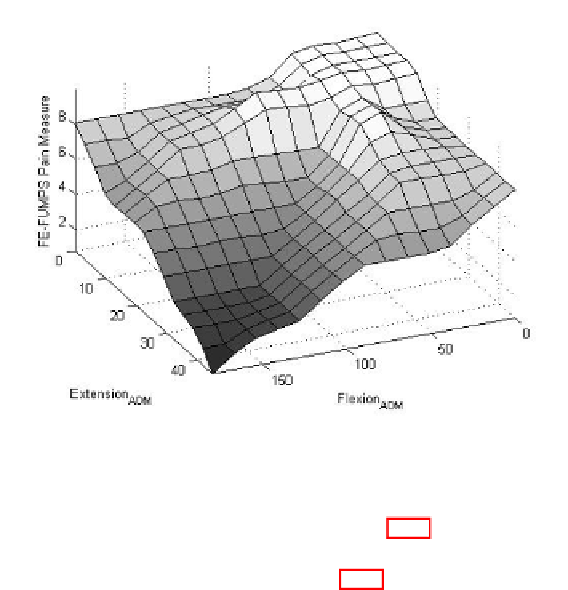Information Technology Reference
In-Depth Information
they are
No
=
0
,
0
,
4
.
5
,
40
.
5
,
Light
=
4
.
5
,
40
.
5
,
49
.
5
,
85
.
5
,
Moderate
=
49
.
5
,
.
,
.
,
.
=
.
,
.
,
.
,
.
=
.
,
85
5
94
5
130
5
,
Intense
94
5
130
5
139
5
175
5
,and
Maximum
139
5
, while for
M
Extension
j
.
,
.
,
=
,
,
.
,
.
=
175
5
184
5
220
they are
No
0
0
1
1
10
1
,
Light
.
,
.
,
.
,
.
=
.
,
.
,
.
,
.
=
.
,
.
,
1
1
10
1
12
4
21
4
,
Moderate
12
4
21
4
23
6
32
6
,
Intense
23
6
32
6
34
.
9
,
43
.
9
,
Maximum
=
34
.
9
,
43
.
9
,
46
.
1
,
55
.
The linguistic terms that part the
output universe of discourse,
intensity of pain
(
severity of disorder
),
Y
,for
M
pain
/
disorder
j
are
Normal
=
0
,
0
,
0
.
3
,
2
.
4
,
Light
=
0
.
3
,
2
.
4
,
2
.
9
,
5
.
1
,
Moderate
=
2
.
9
,
5
.
1
,
5
.
7
,
7
.
8
,
Intense
=
5
.
7
,
7
.
8
,
8
.
4
,
10
.
5
,and
Maximum
=
8
.
4
,
9
.
5
,
12
,
12
.
The overlapping of those linguistic terms, in general, yields a graduated and smooth
classification.
Fig. 24.5
Fuzzy Musculoskeletal Pain Scale (FUMPS) dealing with Flexion-Extension (FE)
Shoulder Range of Motion Analysis (FE-FUMPS)
The surface of the fuzzy model corresponding to (24.2) determines the correla-
tion of the range of motion in shoulder flexion and extension when mapped into the
severity of pain or disorder as depicted in Fig. 24.5. The surface generated from
the fuzzy model corresponds to the decision to stratify the level of pain as well as
the disorder severity. The proposed fuzzy model reveals the direct relation between
the significance of the pain level and the range of motion achieved by the patient.
The last third of each range of motion for shoulder flexion and shoulder extension
reach maximum levels of pain, corresponding to the patient functional limitation,
affecting the muscle and joint component, as available in [1, 16].
24.3.2
Experimental Results
Experimental data are collected in a random population of patients diagnosed with
pain on the shoulder region regardless the kind of medication in use, clinical


